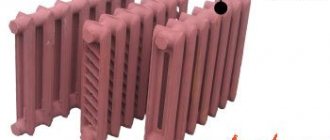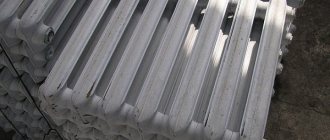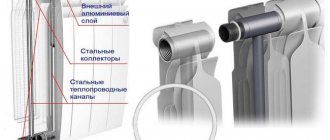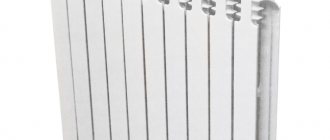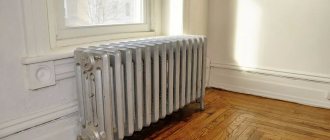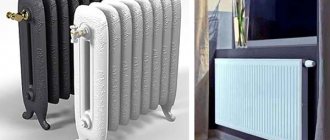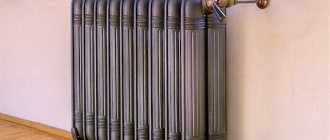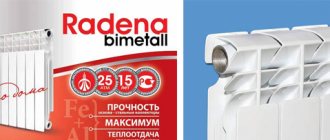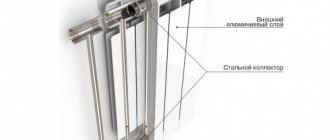The heating radiator market offers a wide range of heating batteries, differing in material, design and external design. Among the wide variety of devices, steel panel radiators occupy one of the leading places in sales. Good heat transfer and ease of installation, a wide range of standard sizes and attractive appearance are what attract the attention of any buyer.
In this material we will tell you everything about panel heating radiators, their distinctive features and design features.
Pros and cons of steel radiators
For the manufacture of such units, low-carbon steel is used. The surface of the product must be covered with protective enamel. Good quality steel batteries have high performance properties. They do not rust and normally withstand various aggressive influences. Tubular and panel steel batteries are available for sale.
Pros and cons of steel radiators
Panel devices are assembled from a certain number of steel plates connected to each other. The finished panels are attached to each other. The features of this assembly made it possible to achieve the highest possible heat capacity. Each plate has a relatively small thickness. As a result, the finished battery weighs relatively little, which is an additional advantage. Various connection options are available.
On average, a standard steel battery is designed to operate at a pressure of 5-10 atmospheres. Experts recommend using such units when installing autonomous heating systems. In simple city apartments, their use is usually impossible due to the fact that the pressure in the central heating system exceeds the values permissible for batteries of this type.
To assemble tubular-type units, steel pipes with high-quality polymer coating are used. The thickness of the pipes directly determines the load they can handle. It is best if the battery is made of stainless steel.
Steel radiator
Also, tubular steel batteries outperform their panel counterparts in terms of service life, which can reach 30 years or more. Connect in accordance with all currently existing methods. Working pressure indicators are usually at the level of 7-16 atmospheres; it is additionally recommended to clarify this point in the product data sheet.
Power determination
The best radiators are heating devices that warm up the room as quickly and completely as possible. To select such a device, you need to calculate the power of the equipment. To calculate, you can use one of the following methods.
By room area
The easiest way to determine the number of heating radiator sections is to calculate by area.
To determine the parameter, you will need to know the length and width of the room. The calculation is made using the following formula:
N = S*100/Рс, where
N – required number of battery sections;
S is the area of the room, defined as the product of the length and the width of the room;
100 – calculated indicator of the required heat per 1 m² of area;
Рс – power of one battery section, which is indicated in the technical data sheet.
For example, the length of a room is 7 m and its width is 4 m. In this situation, the area of the room will be 7 * 4 = 28 m².
We advise you to study - Pros and cons of building with ceramic bricks
The average power of one section of a bimetallic radiator is 200 Watts. Therefore, to maintain the optimal temperature in the room, it is enough to install a bimetal battery with 28 * 100/200 = 14 sections.
By room volume
The most accurate calculation can be made based on the volume of the room, that is, taking into account the height of the ceilings. To determine the number of battery sections you need to use the following formula:
N = S*h*41 (34)/Рс, where
N – required number of sections;
S is the area of the room, defined as the product of the length of the room and its width;
h – ceiling height in the room;
41 or 34 – calculated indicators of the optimal amount of heat per 1 m³ of room volume. Moreover, it is customary to carry out calculations for brick houses with a parameter of 34 W, and for houses made of panels - 41 W;
Рс – power of one section of heating equipment.
For example, it is necessary to determine the number of sections of a steel radiator for a room with overall dimensions of 8 m (length), 5 m (width) and 2.5 m (ceiling height), located in a brick house. The power of one section of equipment is 150 W.
Area (S) = 8*5 = 40 m²
The volume of the room is 40 * 2.5 = 100 m³
Based on these parameters, you will need a battery containing 100*34/150 = 23 sections.
Main features of aluminum batteries
One of the currently most popular types of heating batteries are units made of aluminum. In terms of its properties, it is a very ductile and fairly light metal. Batteries made on its basis are also lightweight and characterized by excellent heat dissipation. Consists of several sections. Each such section is assembled from many plates. This solution makes it possible to make heat transfer as efficient as possible and retain heat at the highest level. Aluminum batteries heat up very quickly. However, they practically do not know how to retain heat. When the heating is turned off, such a radiator will cool down very quickly.
Often aluminum radiators have an original design
Aluminum is an extremely unstable material to various types of chemical influences. In view of this, such heating devices are coated with polymers from the inside, providing reliable protection against a variety of chemicals.
Aluminum cannot be called a durable metal either. Therefore, before purchasing and connecting such a heating device, it is necessary to clarify the operating pressure in the heating system. The maximum pressure that a particular radiator can withstand is usually indicated in its passport, because for different models this indicator may also differ slightly.
Additional disadvantages of aluminum batteries include the not very reliable threaded connection of the top valve, through which air must escape.
Aluminum is an excellent metal, the characteristics and properties of which allow it to be used for the manufacture of a wide variety of products, including heating radiators. The low-fusibility of the material made it possible to significantly expand the range of batteries. Now everyone can choose a battery that will best fit into the interior of their home.
Main features of aluminum batteries
Also among the advantages of aluminum radiators is the relatively low cost, especially when compared with the price of bimetallic devices.
Design features
Bimetallic batteries can have two types of designs.
- Cheaper models are distinguished by the presence of a steel core only in the vertical channels. Such radiators are sometimes called semi-bimetallic. Despite the fact that their characteristics are significantly superior to aluminum devices, they still do not have sufficient strength inherent in full-fledged bimetallic batteries.
- Real bimetallic heating devices have a solid steel frame, which is filled under pressure with an aluminum alloy during the production process.
Separately, we can mention copper-aluminum radiators, which in their characteristics surpass all existing types of batteries. They have excellent corrosion resistance, excellent heat dissipation and a long service life, but their high cost has prevented them from becoming widespread.
General recommendations for choosing heating radiators
Long gone are the days when people tried to hide unsightly-looking heating radiators using various tricks and third-party devices. Today you can choose a battery that will fit perfectly into any interior. Radiators differ from each other in material, size, color design and other indicators, so you can easily choose a battery that can fully satisfy all your needs and fit well into your existing or planned interior.
Today you can choose a battery that will fit perfectly into any interior.
Although radiators made in light colors are traditionally installed in residential premises, it is necessary to take into account the fact that a black device on average gives off 20-25% more heat solely due to its color. In general, when choosing the color of the battery, be guided by your own preferences and the overall design of the room
In residential premises, streamlined batteries look most organic. It is better to avoid radiators with sharp corners for safety reasons, especially if children live in the apartment or house. Any sharp corners in general are a relic that is recommended to be discarded.
For the manufacture of heating units, materials such as aluminum, cast iron, steel and alloys of various metals (bimetallic radiators) are currently used.
Depending on the material of manufacture, radiators will have different heat capacity and heat transfer, operating pressure, their resistance to chemical and hydraulic influences and, of course, service life will also differ.
In terms of cost, the most expensive are steel batteries and bimetallic radiators. Cast iron units are relatively inexpensive. The only exceptions are samples using artistic casting methods and foreign-made designer models.
Special attention should be paid to the environmental safety of the material used to make heating batteries. The main components of safety for human health are high-quality polymer coating and the absence of formaldehyde in internal elements
What's included in the installation kit
It is designed for standard battery connection. Aluminum radiators are connected to pipes on the side, depending on the heating scheme. Various options:
- top/bottom – right or left;
- diagonal connection - supply at the top, return at the bottom or vice versa.
The channel openings in the radiators are 1 inch.
Kit contents
- Footers (4 pcs.). Used if the cross-section of the pipe does not correspond to the diameter of the connecting holes. The set includes 2 pairs of adapters - left and right. They come in 1" to ¾" and ½" sizes.
- Mayevsky crane. It is a manual device that allows air to be removed from the system. It is used before starting the boiler, as well as if the efficiency of the aluminum battery decreases - for example, due to increased gas formation inside the sample. Mounted in the top hole to which the pipe is not connected.
- Stub. There are four docking holes in the battery case. Two are used for connecting pipes (according to the diagram), the third is for installing a Mayevsky crane. The unused hole is plugged.
- Brackets. For mounting an aluminum radiator on the wall.
To install cast radiators, liners are always needed. The reason is the different thread pitch on each side of the battery.
Not all manufacturers supply their batteries with them - please note!
A non-standard connection is called piping from below. The advantage is obvious - communications are hidden under the finishing of the floor. In order to move the side connection of aluminum radiators to the lower position, you will need special fittings, which must be ordered separately.
When choosing adapters of this type, it is advisable to consult a professional. The compatibility of materials – aluminum batteries and fittings – plays a role.
What you will need for installation
- FUM tape. Without it, the threaded connection will leak. A modern analogue of traditional tow, which plumbers rarely use, for large-diameter pipes.
- Sealant. But not the silicone type (the passport for Thermal batteries is specifically stated), the use of anaerobic compounds is allowed. Whether it is needed or not is up to the master to decide.
Additionally
The elements are optional, but if you think about comfort and design, then you should pay attention.
- Screen. To increase heat transfer from radiators. An aluminum battery, like any other, heats the front and back sides. Installing a metal plate on the wall allows you to direct heat rays into the room. The efficiency of the heating device increases.
- Framework. Decorative elements. Thanks to the extensive range, choosing the optimal frame for radiators is easy. You should not neglect them - they protect the radiator from mechanical damage.
- Evaporator, dryer, fan. Additional equipment for heating devices that increases ease of use. Regarding the advisability of purchasing, you should consult with a professional.
Panel radiators with bottom connection advantages and disadvantages
To choose radiators for your home, you need to decide how much power is needed. To do this, you need to know what temperature the water is supplied by the central heating. In general, with the help of specialists you need to calculate the required power of radiators. To determine which connection is better, side or bottom, you need to think about why the side is worse and why the bottom is better, or vice versa. (See also: How to calculate heating radiators)
Radiators with bottom connections are more expensive, since pipes that are laid on the floor can be connected below. If you need a connection from the side, then you need to choose the option of radiators with side connection. It is possible to connect additional pipes from the side. It all depends on the aesthetic characteristics of each person. Tastes and preferences may vary. Each owner of a house or apartment may find certain options for connecting to a central heating system preferable and more convenient.
Radiators with bottom connections come in two types:
- Right-handed
Left-handed
For example, with Purmo panel radiators, you can choose one type of connection or another.
The advantage of such a radiator is largely due to the quality and modern design, which guarantees that the buyer will choose this particular battery manufacturer.
Steel panel radiators Dia Norm are designed specifically for the tastes of modern youth. All requests and whims are taken into account here. The main thing is that the equipment is designed for an energy-saving heating system. And this question is very relevant these days, and it is this criterion that is primarily guided by the buyer when choosing radiators.
Steel is the best material for making batteries at this stage of time, it is better than cast iron and aluminum, since cast iron is too rough, in simple terms, and it is also “old”, while aluminum is too vulnerable and cannot withstand heavy loads
Radiator manufacturers
Once you have already decided on the type of radiator and its power, then you will be faced with the next question - “ Which manufacturer to choose from the large variety offered on the Russian market, which one is better?” There is, of course, no clear answer here. The main thing to note is that the best radiators are made in Europe and most of them are made in Germany and Italy.
If you want to make the right decision and buy a truly reliable and durable radiator, the best thing you can do is consult with us. We cannot openly say which manufacturers are better and which are worse. But we always recommend to our clients what will last longer. And we know more about this than anyone.
How to calculate thermal power and determine the number of batteries
After the homeowner has chosen the desired radiator option, it is necessary to calculate the thermal power, which depends on the following indicators:
- wall material: brick or concrete panels;
- room area;
- type of windows: plastic or wooden;
- the number of window openings and external walls of the home.
The choice of one or another type of heating radiator for an apartment, based on the calculation of thermal power, is carried out for a conditional room with a ceiling height of up to 3 m and window sizes in the range of 1.5-1.8 m.
A simplified calculation, subject to satisfactory thermal insulation of the external walls, suggests using one section of the heating radiator per 1.5-2 m² of room.
The types of heating devices available for sale are capable of delivering different thermal power:
- one – 190 W;
- separate part of the bimetallic battery – 200 W;
- solid steel device - 450-5700 W;
- one section of cast iron radiator – 80-150 W.
As a rule, the manufacturer indicates the power of a solid or sectional heating battery in the passport for its products. The values described above, which determine the amount of thermal energy, are calculated for a coolant with a temperature of 70 ° C.
According to experts, regardless of the choice of unit, when creating a system it is important to pay special attention to such points as the prestige of the manufacturer of heating devices and the individual characteristics of the heating system. As a rule, the best radiators are manufactured by large rating companies
We count batteries by volume
SNiP also has standards for heating one cubic meter of premises. They are given for different types of buildings:
- for brick, 1 m3 requires 34 W of heat;
- for panel - 41 W
This calculation of radiator sections is similar to the previous one, only now we need not an area, but a different volume and standards. We multiply the volume by the norm, divide the resulting figure by the power of one section of the radiator (aluminum, bimetallic or cast iron).
Formula for calculating the number of sections by volume
Example of calculation by volume
For example, let’s calculate how many sections are needed for a room with an area of 16 m2 and a ceiling height of 3 meters. The building is made of brick. Let's take radiators of the same power: 140 W:
- Finding the volume. 16 m2 * 3 m = 48 m3
- We calculate the required amount of heat (the norm for brick buildings is 34 W). 48 m3 * 34 W = 1632 W.
- We determine how many sections are needed. 1632 W / 140 W = 11.66 pcs. Round up, we get 12 pieces.
Now you know two ways to calculate the number of radiators per room.
Information about cast iron batteries
Radiators made of cast iron are the most popular and most familiar option to every resident of the post-Soviet space. These batteries were installed in almost all standard apartments. Old cast iron batteries can hardly be called beautiful and stylish. The new samples look much better, although they are inferior in their aesthetic qualities to devices made of aluminum and steel.
Cast iron radiators
Cast iron is a fairly heavy material. Batteries made from it also weigh a lot, which causes certain difficulties and inconveniences when installing them. Among the undoubted advantages of cast iron radiators, one should highlight their reliability and durability. High-quality products can last 35-40 years without any problems, without even requiring minor repairs, which is much higher than for batteries made from other materials.
Cast iron heats up relatively slowly and cools just as slowly. It is characterized by low thermal conductivity, but has a high heat capacity. Heating is carried out by convection.
Such batteries work normally even with low-quality and dirty coolant. The material is resistant to corrosion damage. The radiators themselves can have a one-, two-, or three-channel structure.
Additional advantages of such heating units include a relatively affordable cost. Only imported designer models are expensive. Here, everyone must decide for themselves what is more important to them: saving a certain amount of money or purchasing a beautiful unit that will become a worthy addition to the interior.
Thus, batteries of any type considered can be used to heat residential premises. But the purchase of bimetallic batteries in most cases turns out to be unjustified. In terms of their properties, such radiators are practically no different from their aluminum counterparts, but are much more expensive. So it’s better to leave them to various public and industrial buildings.
What are the best heating radiators?
Apartment owners are not recommended to choose aluminum appliances, because... Pressure surges have a bad effect on this material. The optimal and proven option for heating city apartments are cast iron appliances. For the rest, focus on personal preferences and available budget. Good luck with your choice!
Marking
Radiators produced by PC DZR LLC have the following markings:
- the inscription “MADE IN RUSSIA” on the engine cooling radiator tanks;
- the inscription “MADE IN RUSSIA” on the heating radiator tanks;
- identification sticker on the top cross member of the cooling radiator or on the side of the heating radiator core (image of the company’s trademark, month/year of manufacture).
The inscription “MADE IN RUSSIA” on the radiator tanks
Identification sticker image
Packaging of DZR radiators
Each product is packaged in an individual box made of high-quality micro-corrugated cardboard. The box flaps are sealed with adhesive plastic tape.
Note!
- How to disassemble a bimetallic heating radiator with your own hands
The individual box has an original high-quality three-color printing design. The individual box contains the necessary information to identify the product packaged in it.
Individual boxes, in agreement with the customer, can be additionally packed in group cardboard boxes. The use of additional group packaging allows the wholesale buyer to maintain the attractive presentation of individual packaging during transportation and loading and unloading operations on the way to the final buyer.
Advantages and disadvantages of bimetallic radiators
A feature of bimetallic batteries is the use of two different metals for their manufacture: the body is assembled from aluminum, and steel is used to create the core. The rod has very high strength.
Advantages and disadvantages of bimetallic radiators
The undoubted advantage of such units is their ability to operate at pressures of up to 45-50 atmospheres! Steel perfectly tolerates the effects of water with various impurities. The aluminum body will heat up quickly and transfer maximum heat into the room.
The combination of different metals made it possible to obtain a product that has the advantages of two materials at once. Such batteries are the most expensive among other existing options. They are usually used to organize heating systems in various public and industrial buildings, shopping centers and other similar places. They are installed relatively rarely in residential premises, primarily due to their high cost. They last an average of 20 years, which is quite a decent indicator.
Advantages of purchasing from us
(St. Petersburg) has been operating in the heating equipment market since 1998. Our reputation is confirmed by the absence of complaints, completed deliveries of products to 1,800 objects of varying importance, reliable and long-term relationships with 3,000 contractors.
We guarantee
- Individual approach.
- Impeccable product quality (only from manufacturing companies with a well-deserved reputation).
- Reasonable cost of radiators without surcharges (direct connections with manufacturers, no chain of intermediaries).
- Constant replenishment and expansion of the assortment.
- Ease of finding the necessary equipment (the online store website teplotorg.ru is available 24/7).
- Efficiency (own fleet of vehicles, compact territorial location of administrative and warehouse buildings, fast shipment, delivery to regions).
Selection rules
It would seem that all radiators existing on the market are largely identical, but they have many differences
Before purchasing a heating device, you should pay attention to some of its features.
By following all installation rules, you will provide yourself with high-quality heating for a long time
Number of panels
This is an important indicator that affects the power of the heating device. The most common radiators contain:
- 1 slab (their thickness does not exceed 6 cm);
- 2 plates (from 10 to 14 cm);
- 3 slabs (15−18 cm).
When comparing all types of panels with the same power, single-panel radiators will be the most effective due to the fact that in such a product both of its surfaces are in contact with air flows. An important advantage of these models is their compactness.
Double-panel models are more powerful than single-panel ones, but not significantly. The additional stove has a power equal to 70% of the power of the main one.
Devices with three panels are the most powerful, but also the largest. Due to their size, they are not used in apartments or houses.
In this video you will learn how to connect the batteries correctly:
Product marking
By carefully studying the labeling, you can find out the main characteristics of the product. The designation is deciphered as follows:
- the first digit indicates the number of panels;
- the second indicates the number of planes with edges;
- the type of connection to pipes is designated as V - bottom, C - side.
Often the markings contain information about the height and width of the panels.
Connection method, performance and equipment
Based on the connection method, radiator panels are divided into side and bottom. When laying heating pipes along walls, it is recommended to choose models with side connections. The most common panels are bottom mounted. The kit with such a product should include a thermostatic valve and a thermal head.
You can install radiators yourself, following the instructions
Any panel heating radiator is in a sense a convector, which increases its efficiency. In products with two or more bottom panels, there are holes at the bottom through which cold air enters and is released through the top, warming up to the set temperature.
When purchasing a radiator that you will install yourself, you should consider the need for additional equipment. Sensors, pipes, taps, etc. may be needed. If you follow the recommendations for choosing a product, as well as fulfill all the conditions for proper installation, the heating radiator will last for many years and will not cause any problems.
In this video you will learn about aluminum and steel heaters:
Standard height
When talking about standard height, we mean an interaxle distance of 500 mm. These were the connecting dimensions of the well-known cast iron “accordion” of Soviet times. And since they have a long service life, these batteries are still used in heating networks. Only now they are being replaced with new ones. Moreover, they often do not want to redo the system, so they look for heating devices of the same size. What's good: they are in almost every group.
Cast iron
Today, not only “accordion” is made from cast iron, although it exists and is popular. There are also retro-style radiators with a center distance of 500 mm, made in a modern style:
- “Accordion” is called MS-140, MS-110, MS-90 and MS-85. These modifications have different depths: 140, 110, 90 and 85 mm, respectively. The width also varies. Moreover, it differs from different manufacturers of the same model. So the MS-140 from the Minsk plant has a width of 108 mm, and from Bryansk and Novosibirsk - 93 mm.
- Cast iron radiators in retro style with a center distance of 500 mm will have completely different appearance and dimensions. Let's say the Modern 500 model. Sections with legs dimensions 645*100*45 mm, without legs 572*100*45 mm, thermal power 93 W. And the other DERBY M 500 has dimensions of 660*174*63 mm and a heat output of 118 W (where the dimensions are designated height*depth*width).
- The new type of cast iron batteries also have a decent range of parameters. Turkish Demrad Ridem 3/500 - 572*98.2*60 mm, Demrad Ridem 4/500 - 572*134*60 mm. Czech Viadrus Style has the following dimensions: height 580 mm, width 60 mm, depth is not indicated due to its nonlinear shape (narrower at the top, wider at the bottom).
Cast iron batteries can have such dimensions today
Aluminum
The dimensions of aluminum radiators are more standardized. Here we can even talk about average values. With an interaxial distance of 500 mm, the average section height is 570-585 mm. The almost standard width is 80 mm. There are options for depth. There are almost flat ones: Russian-made Thermal radiators have a depth of only 52 mm. These are the flattest aluminum batteries. For all others it is 80-100 mm.
Bimetallic
Here the situation is even more standard. There were no flat radiators in this category. On average, the dimensions are as follows: width 80-87 mm, depth 80-95 mm, height 565-575 mm.
The lowest radiator at Global Gl-200/80/D has a height of 200 mm
Steel
Steel panel radiators are rarely produced with a center distance of 500 mm. But still, there are some. For example, the Kermi campaign made the following connecting dimensions specifically for replacement: they are available in the Plan-K and Profil -K line. The Russian one also has standard size radiators: model RSV-1.
Tubular radiators come in a variety of models and sizes. It is quite easy to find the required sizes here. The Russian ]KZTO[/anchor] has it, and the Europeans have it. In this category, they operate more with the overall height - the mounting one, since many people prefer the bottom connection.
How to choose the right heating radiator for your home
Before choosing a heating radiator, you should pay attention to the thermal conductivity of the material from which it is made. The thermal conductivity coefficient shows the intensity of heat transfer through the material
The higher the indicator, the smaller the heating devices can be, and the less space under the window they will take up.
Another point that should not be forgotten when describing heating radiators is the smooth start of the system with a gradual increase in pressure. Failure to comply with this requirement leads to water hammer, which can cause the radiator to fail.
The principle of heating a room with a radiator is convection and radiation. Warm air rises where it mixes with cold air. Traditionally, radiators are located under the window - the main source of cold air in winter. It is worth considering that the battery also heats the outer wall, so some of the heat is lost. Heat loss can be reduced by using a heat-insulating layer with aluminum foil on top. Foil reflects thermal radiation, and thermal insulation does not let heat out.
Currently, there are models on the market equipped with a room temperature controller. In order for air to circulate normally, the distance between the battery and the surface of the wall or thermal insulation must be 3-4 cm. A window sill located above the radiator creates an obstacle to the upward movement of warm air. Therefore, it is necessary to leave a gap of at least 8 cm, and the radiator must be raised from the floor by at least 10 cm. Decorative screens reduce the heat emitted by the radiator. If you still decide to install them, you should raise the screen to a distance of 10 cm from the floor and make holes in the window sill for more active air circulation.
In country houses, the pressure in heating devices is lower than in city apartments. In a country house, the pressure should be no more than 3 atm, so most of the radiators presented can be installed in them.
When talking about which heating radiator to choose, in addition to the operating pressure, you should also take into account the factor of gas formation in radiators.
Heating system type
Single pipe systems can be routed vertically or horizontally. The latter option is most suitable for low-rise dwellings: usually we are talking about one- or two-story houses. Three-story buildings are rarely equipped with horizontal wiring. Vertical wiring is usually used in high-rise buildings. This scheme consists of a pipe coming out of the flow, going to the radiator, and then to the floor. This picture can be observed in all (or almost all) rooms. Sometimes there are cases where two radiators are powered from one riser at once. However, it is not at all necessary that they be in the same room.
The strengths of this scheme are the low installation costs and stability of operation (it is quite difficult to unbalance it). However, if significant changes in the parameters of batteries and pipes occur, this can significantly affect the hydraulic resistance. As a result, only the first two sections turn out to be warm, and the rest of the device remains cold.
Single-pipe wiring is characterized by a gradual decrease in the temperature of the coolant as it moves away from the boiler. The efficiency of heating the battery of the neighbor above (with top supply) is inversely proportional to the heating of the radiator on the floor below. To avoid such situations, a law on common ownership of the heating system was adopted. Now, in order to replace a pipe or heating device, you need to obtain the appropriate permits. High-rise buildings are not so often equipped with two-pipe wiring. This is explained by the large consumption of pipes for its organization. In addition, the large dimensions complicate the balancing of the circuit.
A two-pipe system in a multi-story building has the following diagram:
- Two pipes are brought into the room.
- The hotter part serves to supply coolant to the battery.
- The second removes the coolant that has cooled down after the radiator further.
Thanks to this scheme, the identical temperature of the coolant supplied to all heating devices is achieved
It is important to remember that if there is a change in hydraulic resistance in just one radiator, the entire system can be completely unbalanced. A very small resistance will provoke the passage of almost the entire volume of coolant through this section
Therefore, in the presence of such wiring, installation of control valves is mandatory. Most often these are manual control valves or thermostats.
We advise you to study - How to choose a jigsaw - detailed instructions
Advantages and disadvantages
Panel heating radiators have become popular due to their advantages, of which there are many.
Panel radiators will fit perfectly into any interior
The most significant advantages:
- Multifunctionality. Modern batteries are a convector and a radiator in one device. When using them, no additional devices are required: they are capable of fully heating the room.
- Economical. When comparing a finned battery and a panel radiator, it becomes clear that much less coolant circulates in the first product, but its power is quite high.
- Possibility of temperature adjustment. The panels can be equipped with additional devices that allow you to regulate the temperature mechanically or automatically.
- High heat dissipation. Due to its area, the radiator panel has more contact with the environment than ribbed models. It is based on the principle of convection, its efficiency reaches 90%. Therefore, such a device can warm up even the largest room.
- A wide range and affordable prices make the panels incredibly popular. Steel models are much cheaper than copper, bimetallic or aluminum ones, but they are several times more expensive than cast iron ones.
Overview of panel radiators:
All the advantages of panel radiators are significant. But devices, like any product, also have their disadvantages:
- The radiator cannot be left without coolant for a long time, as this will lead to metal corrosion.
- You cannot use coolant with the wrong acidity. The optimal value should be between 8 and 9.5 pH, otherwise rust will actively develop inside the panel.
- It is not recommended to install them in a central heating system, as water hammer can affect the reliability of the product.
Why do these three types affect the choice of a 500/100 or 500/80 radiator?
Each version of this type of heating operates according to different parameters and the composition of the coolant in the pipeline and radiators. Autonomous systems up to 500 m2 - the pressure in the system cannot be more than 3 Bar (kilogram) and the coolant, if desired, can be filled without unnecessary chemicals that accelerate the aging process of equipment.
Autonomous systems over 500 m2 - roof boiler room for residential apartments in a multi-storey building, the pressure depends on the height of the building, but not more than 6 bar (kilogram) with a conventional coolant (tap water).
Centralized heating of apartment buildings and non-residential premises is the most problematic heating system throughout our homeland, the pressure in such systems reaches 9 Bar (kilogram) with a coolant that contains chemical reagents and a lot of dirt.
All of the above affect the durability of your batteries and the connections (pipes and taps) to them. Knowing the system and the factors of their problems, consider the heating devices themselves, and in the next article we will decide which pipes and taps to install.
